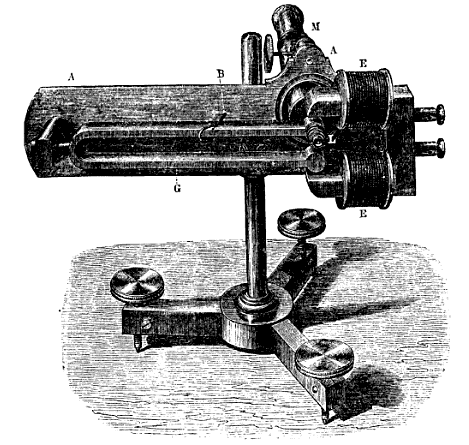There are a number of fundamental principles concerning the sound production of stringed instruments that are both fascinating and important. One of these is the “Helmholtz Motion of the vibrating string.” Understanding the physics behind the instruments we play can make us more thorough and complete musicians. Unfortunately, principles such as this are not always explained very clearly in method books about string playing. In order to understand these concepts more easily so they can be opened for discussion here at String Visions it is helpful to first go back in time and trace the history of string acoustics.
Hermann Von Helmholtz was an incredible scientist who achieved a staggering number of scientific discoveries during his life. He was the first person to see and explain how the strings of a bowed string instrument vibrate. [1] In his revolutionary book On the Sensation of Tone, Helmholtz explains what he saw through using his special vibration microscope. In Helmholtz’s own words:
“By applying a peculiar method of observation. I have found it possible to observe the vibrational form of individual points in a violin string, and from this observed form, which is comparatively very simple, to calculate the whole motion of the string and the intensity of the upper partial tones.” [2]
To the naked eye the vibrating string seems to be moving back and forth in a parabola-like shape. Helmholtz, however, observed that the string in fact moves in very unexpected ways: in a “V”-shape, i.e. the string gets divided into two straight portions which both meet at a sharp corner. The fact that we see a gently curving (parabola-like) outline of the string’s motion with the naked eye is because the sharp corner moves back and forth along this curve. Hence we only see the “envelope” or outline of the motion of the string. This “V” shape motion became known as the Helmholtz Motion. [3]
Follow this link to see how sticking and sliding friction works. [4] The sticking phase is when the string sticks to the bow and moves along at the same velocity as the bow, and the slipping phase is when the string slips back in the opposite direction at a much higher speed.
See this video for the Helmholtz Motion in action with a real bow and violin string: http://www.youtube.com/watch?v=KPpBvHXYWz4
You can also very clearly see how the eye recognizes the parabola-like shape of the vibrating string:
https://ccrma.stanford.edu/realsimple/travelingwaves/Helmholtz_Motion.html
To really understand the Helmholtz motion of the vibrating string spend some time observing and studying these videos because a picture is worth a thousand words.
[1] It is assumed that you have some basic knowledge about bowing and the vibrating string. If not, follow this link: http://www.ehow.com/how-does_7238083_violin-bow-work_.html
[2] Helmholtz, Hermann L. F. On the Sensation of Tone as a Physiological Basis for the Theory of Music. 2nd English Ed. Trans. Alexander J. Ellis. London: Longmans, Green, and Co., 1954. Page 80. For a fascinating read go to chapter 4 “Musical Tones of Bowed Instruments” and read for your self the whole experiment as explained by Helmholtz. The book can be downloaded from Google Books. This revolutionary experiment was an incredible yet small part of all the amazing discoveries he did in his research.
[3] Woodhouse, Jim and Paul Galluzzo. “Why is the Violin So Hard to Play?” +Plus Magazine 31, September 1, 2004. http://plus.maths.org/content/why-violin-so-hard-play
[4] Ibid.















Thanks, this is a nice introduction to Helmholtz motion. I also use to show that Youtube video of the bowed string in slow motion. Another good source of information about this topic (and many other topics related to music acoustics) is provided by the Music Acoustics group at the University of New South Wales (Sydney, Australia), see http://www.phys.unsw.edu.au/jw/Bows.html
This is bad theory. The shape of a string detained between two points is not a sine wave or the sum of sin waves. Euler showed the shape of a vibrating string is a concatenation. Even if the string is a “parabolic shape”, the fact that the fundamental defines the system as an arrow with a 1, or just a 1, means that any modes of vibration that are within the “parabola” are in fact multiples of some other fundamental than the system fundamental. For example, in the monochord device, the higher overtones on the string each have their own unique fundamental. More importantly, Helmholtz’s notion that pitch and frequency are the same is tantamount to assuming that the cycles on the interval 2 pi are trigonometric when in fact cycles are Zahalen. Every textbook has this absurd illustration where the fundamental is shown with the higher overtones n = 1, 2, 3, 4, .. as if they are all there in the string when it is very obvious the concatenation form must detain the higher overtones to the parabola. Just because you can drive the string into harmonic modes by detainment does not prove they exist in the concatenation shape. The V shape of the string when plucked only exists when the string is detained at 3 points. Helmholtz’s methods preceded spectral theory and are clearly obsolete mathematics.
This site is completely awesome. I’ve looked these details a whole lot and I view it that is professional, easy to understand.
I congratulate you because of this research that I am going to tell to the people friends.
I ask you to recommend the gpa-calculator.co page where
each pupil or pupil can find ratings grade point average marks.
Success!
QH88- Link yao nhà cài uy tin mái nhat https://gh88.cfd
QH88 cung cap dich yu casino truc tuyén yà slot game chat luong cao. Giao dien hien dai, ho trg nhiet tình yè uu dai háp dàn cho nguài chai.
EE88 – Nhà cái ee88 casino | Link đăng nhập ee8801 nhận 88k https://ee88.cash
123B ⭐️ Link Tải 123B Không Bị Chặn Mới Nhất 02/2025
https://123b.compare